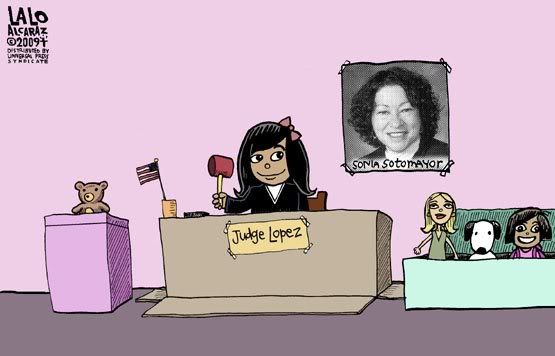From the outset we all celebrated the first Latina Supreme Court Justice as well as two more women serving on the court.

Of course we heard from the poutragers about how "centrist" both of these women were and that it was yet another example of their disappointment in President Obama.
But what has happened as a result of their actual time on the court? Recently we got a good look at Justice Kagan when she wrote a blistering dissent to the majority decision on the Arizona campaign finance law. Here's how Heather Gerken described it.
I just finished reading Arizona Free Enterprise Club's Freedom Club Pac v. Bennett, today's Supreme Court decision invalidating Arizona's public financing scheme under the First Amendment. I was struck by how strongly worded the opinions were. The majority and the dissent bordered on vituperative. Chief Justice Roberts and Justice Kagan write as if they were exasperated with one another. Each accuses the other of ignoring facts, ignoring doctrine, even ignoring the basic principles undergirding the First Amendment. The two go so far as to invoke each other's rhetorical flourishes ironically, even sarcastically.
Why so much heat? It may be a sign of a nascent rivalry between Chief Justice Roberts and Kagan. But I think it also has to do with the state of campaign finance doctrine. What we are witnessing is not a doctrinal framework developing and moving toward a shared middle ground. What we are witnessing is a doctrinal death match between two incompatible world views. The stakes are high, and so is the rhetoric.
And what about Justice Sotomayor? David Fontana wrote a more general review.
Monday was the last day of this year's Supreme Court term — one widely seen as notable not for what was decided but, rather, for coming before what could be a momentous 2012-2013 term, when decisions on gay marriage and health care, to mention just two issues, could be handed down. Years from now, however, we might be talking about this term as significant for another reason: It was when Sonia Sotomayor became the most well-known and effective member of the Court's liberal wing.
When Sotomayor was nominated to the Supreme Court in 2009, many liberals were unhappy. This unease was only magnified by her confirmation hearings. The Washington Post said that there was "little for liberals" in the hearings, and former University of Chicago Law School Dean Geoffrey Stone argued that they "did serious damage to the cause of progressive thought in constitutional law."
Now, almost two years later, while the returns are preliminary, there are reasons for liberals to be optimistic. In her first 18 months on the Court, Sotomayor has proven to be what the Los Angeles Times has called a "reliable liberal vote." Meanwhile, The New York Times has noted that Sotomayor has been "alert to the humanity of the people whose cases make their way to the Supreme Court. Slate said her opinions about Miranda warnings reflected that "empathy for the vulnerable isn't merely a choice but a necessity."
But what is most consequential about Sotomayor's time on the Court is how what she has done on the bench combines with what she has done away from it. Sotomayor has become the public face of the Court's liberal wing because she seems to be what so few justices are: a real person, with the jurisprudence to match.
Justices Sotomayor and Kagan - you make us proud!
And thank you President Obama for nominating such strong, intelligent, empathetic women to the Supreme Court of the United States.




No comments:
Post a Comment